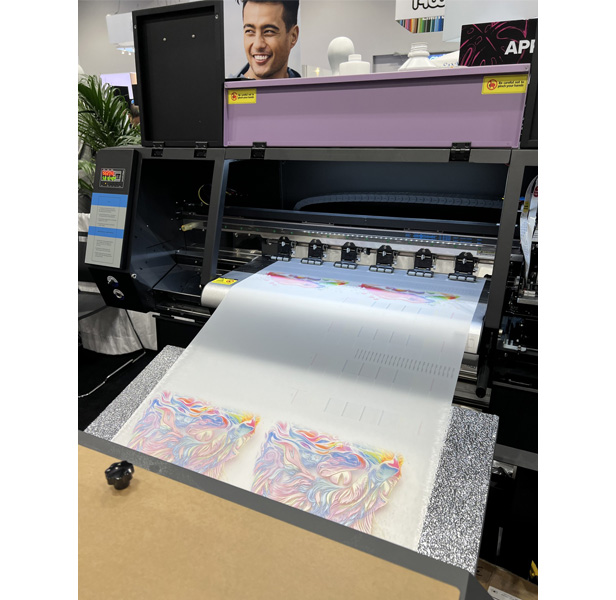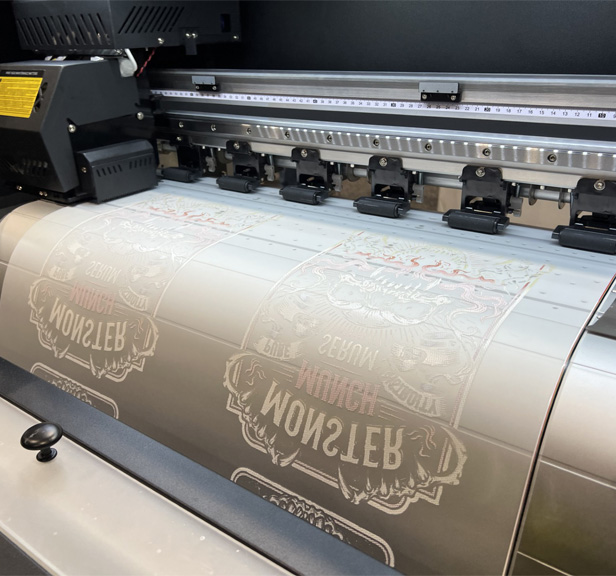Key Takeaways
• Direct-to-film (DTF) technology is revolutionizing the decoration industry by lowering barriers to entry and enabling entrepreneurs to scale operations through outsourced transfers and in-house production.
• Investing in DTF equipment demands careful consideration of financial readiness, facility space, staffing and environmental conditions like humidity, which directly impact print quality and maintenance costs.
• While DTF is a powerful tool with high-volume capabilities, it’s best viewed as part of a broader decoration tool kit alongside screen printing, DTG and embroidery, offering flexibility for diverse customer needs.
Cassie Green began her panel with something of an understatement.
“We all know direct-to-film is kind of a big deal right now,” said the content director for Apparelist at PRINTING United Alliance.
In her panel, “DTF Printing Deep Dive: Best Practices, Industry Impact and Winning More Customers,” on Oct. 23 at PRINTING United Expo in Orlando, Green and her panelists guided the audience through the past, present and future of direct-to-film (DTF) decoration, with a definite emphasis on the “future” part.
The panelists – Rob Super, CEO and founder of American Print Supply, and Deana Iribe, training and marketing content manager for Printer Biz and owner of The Print Bakery – have both been heavily involved in the DTF wave, and understand not only the nuts and bolts of optimizing the technique for quality decoration but also the benefits and limitations of the technology.
Is DTF Right for Your Business?
Green led the conversation by asking the panelists about the right time to invest in DTF printing equipment. How do you know that it’s the best move for your business? It is, after all, no small investment.

“I don’t think there is any right, magical answer,” Super said. “It’s really business dependent.”
If Super had to say at what point it becomes more financially viable to bring production in-house, it would be producing revenue at “two times the cost of a lease payment,” he said.
“If you’re shopping around for commercial printing equipment, what is that monthly lease payment? And if I’m making two to three times that revenue in decorated apparel while purchasing outsourced transfers, that’s a good indicator that now I’m leaving money on the table, and this is something I want to look at,” he said.
From there, it’s a matter of personnel and space.
“Do I have the facility? Do I have the staff?” Super asked. It sounds simple, but something like having a wide enough door to get the equipment into the facility is something printers need to consider.
More important than that, Super said, is the staff.
“If I’m a sole entrepreneur, if I’m spending time running the printer, doing maintenance on the printer, I’m losing sight of my sales,” he said.
Managing Variables
If at this point, a printer is sure that investing in their own print equipment is the right move financially for their business, there are still more things to take into account beyond just space and staff.
Iribe brought up environmental factors – literally the environment in which you would print on – that some printers might not think about.
“With any technology that requires white ink, we would like you to have at minimum 45% [humidity],” Iribe said. “The more humidity that you have in the air, the more moisture there is around the print head, the less likely it is that it will dry out in the printing process.”
Without proper humidity, Iribe said that the ink can dry up and go back into the print heads, which then requires an auto-clean of the machine.
“Every time you do an auto-clean, you’re literally throwing money down the drain because the ink is going down your tubes,” she said. The good news is that the issue can be avoided by investing $100-$500 in a humidifier.
The Future of Print
DTF is certainly a disruptor of the print industry. And while screen-printing purists might still say that it has its drawbacks, DTF technology allows for people to join the decorated product space that otherwise might not have been able to due to financial barriers to entry or space constraints.
“The first thing I love about it is the economics of it,” Super said. “It’s so cool to see how many different people can make money with the direct-to-film technology. I can have a printer and I can sell transfers to other local businesses. They can buy that and I can make a good margin on that just selling the transfers. That’s about as easy as it gets in the decoration world – printing something out on a good quality DTF printer, rolling it up in a tube, having UPS take it or they come pick it up. And that’s good money that can supplement your decoration business right there alone.”

That buyer then is also part of the ecosystem and can decorate those preprinted transfers on items like apparel.
“They do the decoration, and now they can resell it to someone with a good margin, because these are premium products,” Super said. “There are so many different ways in the economics of it. It’s really crazy potential, and that’s what I love about it.”
As to DTF’s rivalry with screen printing, Super said that it’s less of a zero-sum game and more of a situation of choosing the right tool for the right task.
“We’re seeing more and more screen printers, hardcore rotary shops all throughout the country, taking note of DTF because it is a powerful tool,” he said. “As I like to say, a good mechanic wants to have the best tools in a toolbox. And so, if I’m dead set on screen printing being the only way to go, I think they’re going to miss the boat and their business is going to suffer.”
The common misconception, he said, is that DTF print is only for high-color, low-production runs. But that’s not the case anymore.
“There’s some really high-volume equipment out there,” said Super. “So, if those companies don’t take note saying, ‘Hey, I want to put some automation and some high-efficiency production equipment into the shop and use it as a tool,’ they’re going to be sorry.”
Iribe herself was a self-professed “DTF hater” only two years ago but has now changed her tune. She’s not sure whether it will fully replace other decoration techniques like DTG or screen print, but she said that she has recognized its potential in the marketplace.
“When you have a toolbox, it’s not all the same tool,” she said. “You’re going to have a screwdriver, you’re going to have a hammer, you’re going to have other options that you need to be able to fulfill a want or need. The way that I see direct-to-film is that it covers a lot.”
Some jobs, like polyester or synthetic, are best for direct-to-garment printing, for example. By that logic, Iribe said that it’s foolish to pigeonhole yourself to one decoration style in the same way that it would be foolish to make any apparel campaign a one-size-fits-all giveaway when we live in an era where people want something that feels custom-made just for them.
“It’s not going to replace some specific niche tools that you have, whether it’s screen printing or embroidery or whatever,” Super said. “But it does a lot of things really, really well.”
Super said that he believes that within the next five years, DTF printing will reach a point where we see high-volume production shops, similar to those that exist in the screen-printing world, where they are printing 300, 400 or even 500 pieces an hour with a single operator or two-person operation.
While Super’s future vision was grander in its scale, Iribe focused on the entrepreneurs who are venturing into print and maybe don’t have the square footage for huge operations just yet.
“There’s nothing wrong with starting your business in your home,” she said. “There’s going to be more of an in-between of the little desktop printers that you’re seeing around here and industrial. Maybe something in a $10,000 range, maybe more of a $13,000-ish or $17,000-ish, but something that can help you compete with other people printing with starting out of your home.”



